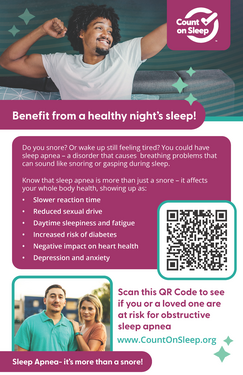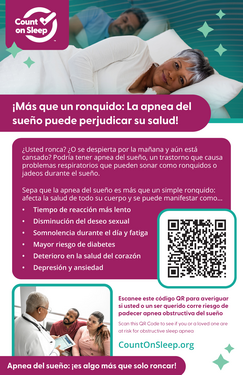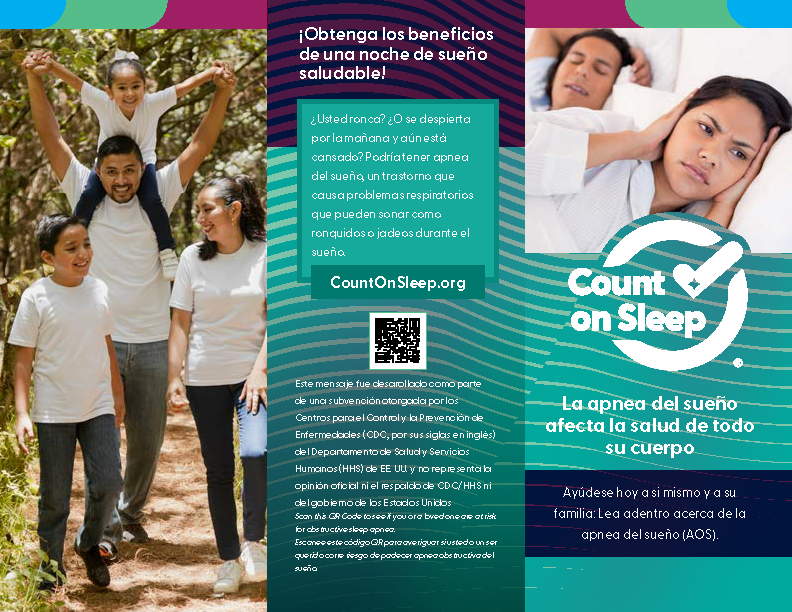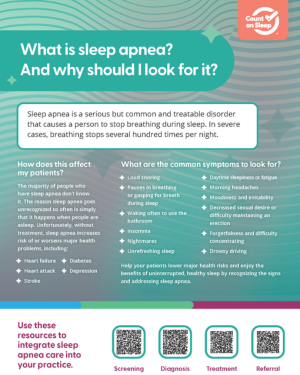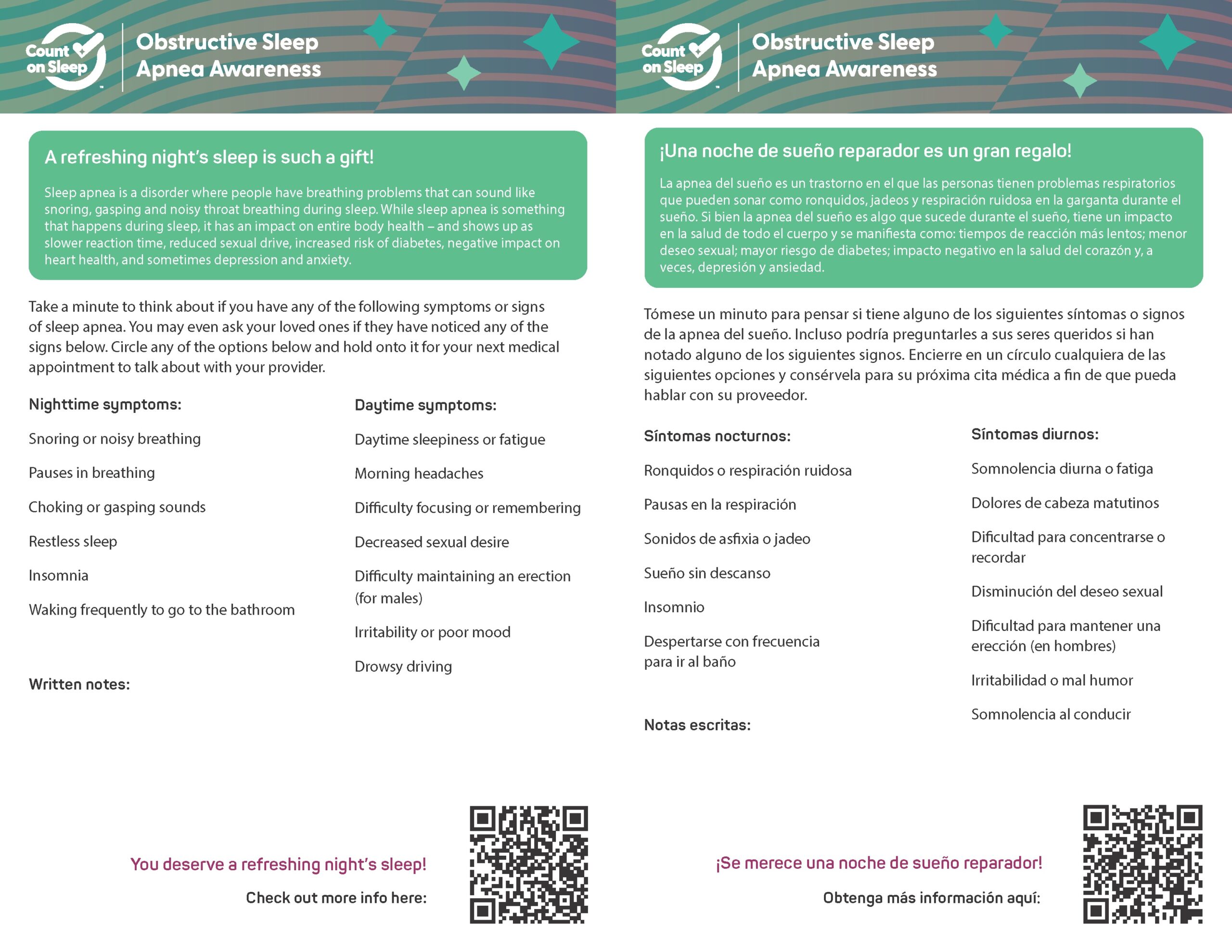OSA Awareness Resources
Healthcare professionals can easily integrate care for OSA into their practice with the use of these practice resources. Learn more about the importance of screening, utilize algorithms that detail the path from screening to treatment or referral, and access practical tools for OSA care, such as an easy-to-use screening tool, template referral form, and treatment tips.
- Free CME Course – Obstructive Sleep Apnea (OSA) Screening
Made Simple: Effective Strategies for Healthcare Professionals - STOP-BANG screening tool
- Additional evaluation tool: Epworth Sleepiness Scale
- Template referral form
- Find your nearest AASM accredited sleep center
- PAP troubleshooting FAQs
- Comorbid insomnia and sleep apnea (COMISA)
Downloadable Resources
Poster: ¡Más que un ronquido: La apnea del sueño puede perjudicar su salud!
Print and display this attractive poster in your office to help Spanish speaking patients and caregivers understand the effects of untreated sleep apnea
Type: PDF with QR code For: Healthcare Professionals | Language: Spanish | File size: 11 x 17 inches
Provider Handout: What is sleep apnea? And why should I look for it?
A one-page handout that will help healthcare professionals understand the common symptoms of sleep apnea along with QR codes to algorithms for screening, diagnosis, treatment, and referral processes.
Type: PDF with QR codes For: Patients | Language: English | File size: 8.5 × 11 inches
Patient Tool: A refreshing night’s sleep is such a gift!/¡Una noche de sueño reparador es un gran regalo!
Download this 2-sided tool on typical daytime and nighttime symptoms of sleep apnea for a smooth ‘consult’ conversation with patients.
Type: PDF with QR code For: Patients | Language: English and Spanish
Patient Tool: Solutions to common PAP issues
Don’t let common CPAP problems keep your patients from getting the sleep apnea treatment they need. Download this handy 2-sided tool to share with your patients some of the most common CPAP problems and how to overcome them.
Type: PDF For: Patients | Language: English

Sleep disorders with cardiac issues are a severe medical condition that requires immediate attention. In this short video, Lara M Wittine, MD, FCCP, discusses a case where a patient was exhibiting cardiovascular symptoms and was ultimately diagnosed with sleep apnea and treated. This case highlights the need for OSA screening in primary care settings, especially among middle-aged and older adults so they can benefit the most from early intervention.

Obstructive sleep apnea (OSA) and insomnia are often thought of as opposing clinical conditions, specifically in regard to alertness and sleepiness. In this short video, Earl C. Crew, PhD, DBSM discusses a case where a patient presenting with a discrepancy between subjective and objective assessment of sleep; features typical of paradoxical insomnia was diagnosed with sleep apnea. This case highlights that older adults presenting with features similar to paradoxical insomnia should be examined for signs of sleep apnea, and a PSG should be conducted for a definitive diagnosis.

In this short video, Dr. Rubina Nguyen, DDS, discusses a case where a patient was diagnosed with sleep apnea and ultimately treated with an oral appliance. While CPAP is the first line treatment for improving airflow for people with sleep apnea, many find it challenging to use as demonstrated in this case. People with mild to moderate OSA or those with severe OSA who can’t tolerate PAP are more likely to benefit from oral appliance therapy. A customized oral appliance along with an individually tailored treatment plan is key.

Primary care is the front door to our health systems. A very small percentage of patients with sleep-related symptoms who regularly visit a primary care clinician report their symptoms to their clinician without being asked about sleep. So, just asking the right questions can go a long way in screening for obstructive sleep apnea. Take a look at this brief video to learn how to initiate conversations about sleep apnea.

It is imperative for primary and family care providers, cardiologists, bariatric surgeons, endocrinologists, and other health care professionals to identify patients with symptoms of OSA. See how obstructive sleep apnea symptoms are common with several comorbid conditions in this brief video.

The reported prevalence and severity of obstructive sleep apnea in women is lower, compared with men, but the consequences of the disease are the same. Interpretation of the STOP-BANG questionnaire is nuanced for women because the gender question response is 0. Nevertheless, the tool is still useful for prediction of moderate-to-severe disease. Given the nature of its questions, a lower score may be predictive of more severe OSA in women. Watch this brief video to see how women present with atypical symptoms, and how to ask them about their sleep.
Clinical vignettes are case reports that provide insight into clinical practice. In this series, expert clinicians respond to adapted patient scenarios as they would emerge in clinical practice to demonstrate appropriate care pathways for patients with OSA. The clinician responds as new information is presented, sharing his or her reasoning with the reader. Our aim is to promote appropriate medical care. While OSA often goes undiagnosed, known (and sometimes obscure) risk factors, symptoms and assessment tools can help primary care physicians and other healthcare professionals identify the disease.

A 36-year-old man was admitted to the emergency department after being involved in a minor vehicular accident at his workplace. Although the accident was minor, he was unconscious at the time of the incident and regained consciousness approximately 5 minutes later. Further investigation into the case revealed an underlying issue when a referral to the Department of Occupational and Environmental Medicine for a fitness-for-work assessment led to the diagnosis of obstructive sleep apnea. The patient received appropriate management, eventually enabling him to be deemed fit for work. Read more about how this case highlights the critical role of thorough evaluations in uncovering and addressing undiagnosed obstructive sleep apnea.

A 47-year-old Latina woman presented to her primary care physician with a chief complaint of dreaminess during the whole night for the past 2 decades. Her symptoms had progressively worsened in the last 6 to 7 years, and despite consulting numerous specialists, no definitive diagnosis was reached. She felt tired in the daytime with occasional sleepiness and was anxious about the poor sleep quality. Explore this intriguing case of undiagnosed severe obstructive sleep apnea (OSA), where the patient notably improved following the initiation of continuous positive airway pressure (CPAP) therapy.

A 53-year-old woman visited her primary care physician with an 18-month history of recurrent vertigo episodes accompanied by nausea and vomiting. She reported fluctuating tinnitus, hearing loss, and a sensation of fullness in her right ear. Additionally, she struggled with sleep disturbances related to her symptoms. This case vignette highlights how specific treatment approaches led to notable improvements in the patient’s condition, reducing her symptoms and improving her overall quality of life.

A 47-year-old man visited his family physician with intermittent fever and malaise that had persisted for about three months. Given his history of snoring and a weight gain of over 20 pounds in the past year, obstructive sleep apnea (OSA) emerged as a potential contributor to his symptoms. Read the case vignette to understand how targeted treatment interventions significantly improved the patient’s condition, alleviating his symptoms and enhancing his overall health.

A 50-year-old man presented to urgent care with complaints of redness, burning eyes, and nonspecific ocular irritative symptoms that began upon waking. Explore this case to gain insight into the patient’s medical history and discover how effective treatment for obstructive sleep apnea not only corrected his apnea and hypopnea, leading to significant improvements in both nighttime and daytime symptoms, but also provided rapid relief from symptoms related to floppy eye syndrome.

A 20-year-old male with a medical history of severe autism spectrum disorder (ASD) and seizure disorder visited his family physician with his mother, who was seeking guidance on improving her son’s sleep habits. The physician’s foresight and patience were crucial in addressing the complexities of managing his sleep apnea, especially given that the patient is nonverbal and low functioning. These factors presented unique challenges that required a tailored approach beyond what is typically necessary for patients with ASD.

A 61-year-old man visited his primary physician with chief complaints of multiple ‘seizure- like spells’ both in nighttime sleep and during daytime naps. They had been progressively worsening and were often accompanied by an odd expiratory noise. This case highlights that not all nighttime spells are seizures, underscoring the critical need for accurate identification to guide appropriate diagnosis and treatment.
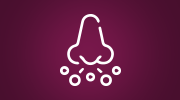
A 58-year-old individual with a persistent left nasal obstruction over recent months was directed to the ENT clinic by their primary care provider. Discover more about this case involving a patient diagnosed with both sleep apnea and COPD who underwent a combination treatment involving nasal surgery and PAP utilization. This led to favorable outcomes in managing obstructive sleep apnea (OSA) and a notable enhancement in his quality of life.

A 52-year-old Caucasian man presented to his primary care clinic complaining of 4-6 awakenings a night to urinate since a couple of months. He had been cleared by his urologist, but he exhibited classic signs of sleep apnea prompting his primary care physician to follow through, evaluate and refer to a sleep expert to alleviate his symptoms. This is an unusual case where nocturia and enuresis are important symptoms of sleep-disordered breathing.

A 60-year-old African American gentleman visited his primary care physician complaining of passing foamy urine and swelling in his hands and face for a week. Explore this intriguing case of undiagnosed severe obstructive sleep apnea (OSA), presenting with proteinuria which notably improved following the initiation of continuous positive airway pressure (CPAP) therapy, with no alterations in medication or body weight. Explore the patient’s medical background and the collaborative effort between the primary care provider and a sleep specialist that led to the alleviation of his symptoms.

A 46-year-old obese man, and suffering from arterial hypertension, visited his primary care physician with a one-year history of chest discomfort, brief episodes of dizziness lasting 10–20 seconds, and a perception of irregular heartbeats. Given the potential link between cardiac issues and sleep apnea, the consequent referral to a cardiologist involved essential measures to identify and address sleep apnea in this patient. Explore the details of this case to understand the steps taken to improve the patient’s well-being.

A 58-year-old male of African American descent, employed as a postal motor vehicle operator, underwent evaluation in the Emergency Department (ED) after being involved in a motor vehicle accident. He had reportedly lost consciousness while driving. Explore the details of the case, including the comprehensive assessment that ultimately led to the diagnosis of obstructive sleep apnea, and the positive outcomes observed after his treatment.

A 35-year-old woman of Black Hispanic ethnicity, at an estimated gestational age of 33 weeks, attended her family doctor’s clinic for a routine checkup. Delve into this case to examine her medical history, understand how the primary care provider, before transitioning her care to an OB/GYN, reassessed her snoring, leading to the identification of severe obstructive sleep apnea. Explore how the subsequent treatment intervention played a pivotal role in improving the patient’s condition.

A 74-year-old male presented with severe depression, excessive daytime sleepiness, and suicide ideation with a suicide-attempt plan. Read this case to learn more about this patient, his medical history, how the primary care provider recognized that sleep disturbances may be a marker of distress and suicide risk and how treatment of sleep apnea led to the resolution of depressive symptoms and suicide risk.

A 33-year-old presented to his doctor’s office for an annual physical examination. He said he was stressed at work and had been feeling irritable on a number of occasions. He complained of daytime drowsiness and dozing while at work. His partner added that he snored at night as well. His general health status was good, and his BMI was in the normal range. Read this case to learn more about this patient, his medical history, how the primary care provider recognized that sleep apnea can present atypically, then managed his complaints by collaborating with a qualified dentist, and the final outcome of the case.

A 61-year-old female of the Te-Moak Tribe of western Shoshone Indians of Nevada visited the local Southern Bands Health Center with a 5-year history of chronic dry cough that was worse at night and during the winter months. Read this case to learn more about how chronic cough can be the sole presenting symptom for some patients with obstructive sleep apnea, and how the patient’s primary care physician recognized confounding factors leading to a good clinical and objective response to CPAP therapy.

A 54-year-old female patient, presented with complaints of waking up with frequent headaches, fatigue, inability to concentrate, anxiety and mood swings. Although diagnosed as having mild OSA in the past, the patient is extremely symptomatic. She had been prescribed a CPAP but was non-compliant. Read this case to learn more about this patient, her medical history and how a multi-disciplinary approach improved the patient’s quality of life and overall health status outcome.

A 35-year-old transgender man (assigned female at birth) presented to the primary care clinic for his annual physical visit. He wanted to discuss his persistent snoring and excessive daytime sleepiness that he has been experiencing recently. Read this case to learn more about this patient, his medical history, how the primary care provider recognized that exogenous testosterone administered for gender reassignment can cause sleep apnea and managed his complaints, and the final outcome of the case.

A 32-year-old Chinese man presented to the emergency room with weakness and inability to walk, resulting in a fall. Read this case to learn more about this patient, his medical history, how further investigations, and testing helped the emergency physician identify sleep apnea as the cause of his stroke followed by treatment options.

A 45-year-old male of African American descent presented to his primary care physician’s office for his six-month checkup. He has had type 2 diabetes for 5 years. He complains that he has been seeing all objects with a greenish tinge in both eyes for a month. Read this case to learn more about this patient, his medical history, how the primary care provider highlights the need to keep in mind the presence of OSA in diabetic patients who can present with color vision problems, and final outcome of the case.

A 42-year-old female of Asian descent was admitted to the ward with complaints of dyspnea and squeezing chest pain without radiation during mild to moderate physical activity, pitting edema of the lower extremities, nocturia and treatment for resistant arterial hypertension (AH). Read this case to learn more about this patient, her medical history, how the primary care provider expanded the questioning to dig deeper, additional testing performed and final outcome of the case.
- The Philips consent decree and the path forward – featuring Drs. Peter Gay, Aneesa Das, and Robert Owens
- NIV and other considerations for the Philips Respironics PAP device recall – featuring Dr. Lisa Wolfe
- Improving patient understanding of sleep apnea – featuring Dr. Rebecca Robbins and Dr. Suzanne Bertisch
- OSA proteomics and metabolomics – featuring Dr. Laura Castillo, PhD and Dr. David Gozal, MD
- Improving patient understanding of sleep apnea – Featuring Rebecca Robbins, PhD and Suzanne Bertisch, MD, MPH
- Telemedicine reliability in screening for sleep apnea – Featuring Michael Yurcheshen, MD
- How sleep depth could impact CPAP adherence – Featuring Amy Bender, MD
- Medications to treat OSA – Featuring Sanjay Patel, MD
- Medical Marijuana and OSA: The POTcast – Featuring Bhanu Kolla, MD
- When to consider surgery to treat OSA – Featuring David Kent, MD and Jeff Stanley, MD
- OSA and cardiovascular disease – Featuring Susan Redline, MD
- Cardiac complications in undiagnosed OSA – Featuring Frances Chung, MD
- The Nose and OSA: Why the nose always seems to know – Featuring Jolie Chang, MD
- Sleep and Cancer – Featuring Jaspal Singh, MD
- Untreated OSA and Alzheimer’s Disease – Featuring Andrew Varga, MD
- Comorbid insomnia and sleep apnea (COMISA) – Featuring Alexander Sweetman, PhD
- Sleep disorders in women – Featuring Andrea Matsumura, MD
- Beyond the AHI – Featuring Daniel Gottlieb, MD and Douglas Kirsch, MD
- In defense of CPAP treatment – Featuring Susheel Patil, MD
- Predicting HGNS treatment success – Featuring Raj Dedhia, MD
- The microbiome and sleep apnea – Featuring Andrew Goldberg, MD
- Phenotyping in OSA – Featuring Allan Pack, MD
- Clinical considerations for novel sleep technology – Featuring Scott Ryals, MD and Steven Holfinger, MD
- The science of smart beds – Featuring Raj Mills, President Sleep IQ
- OSA and PLMD – Featuring Dr. Gulcin Benbir and Dr. Lourdes Del Rosso
- Tirzepatide & OSA: Implementation for Sleep Clinics – Featuring Dr. Atul Malhotra, Dr. Radhika Breaden, Dr. Jeremy McConnell, and Dr. Rafael Sepulveda-Acosta
- Defining Well Treated Obstructive Sleep Apnea – Featuring Dr. Barry Krakow
- KPAP: Exploring a Novel PAP Therapy Approach – Featuring Dr. David White, former AASM president, and Dr. William Noah, inventor of the V-com device
- Should PAP be a Tool for the Obstetrician? – Featuring Dr. Louise O’Brien
- Silent and sleepy: The use of wake-promoting medications in well-treated OSA – Featuring Dr. Kingman Strohl and Dr. Lucas Donovan
- AASM clinical practice guidelines
- AASM Obesity and OSA Fact Sheet
- AASM diagnostic testing of OSA webinar
- Overview of sleep disordered breathing webinar
- Sleep apnea and stroke webinar
- An update on oral appliance therapy for OSA webinar
- Overview of hypoglossal nerve stimulation webinar
- Surgical evaluation and treatment of OSA webinar
- Billing and coding in sleep medicine webinar

